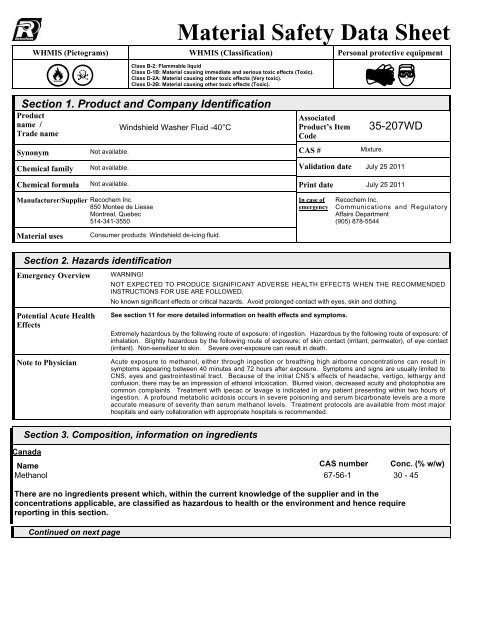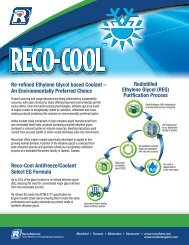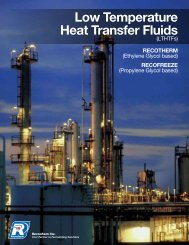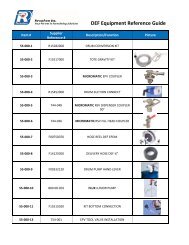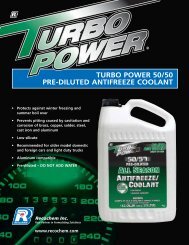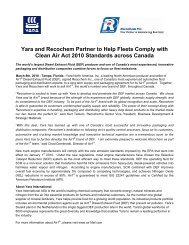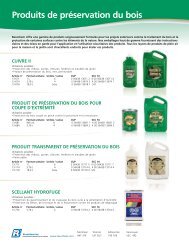Download MSDS sheet - Recochem Inc.
Download MSDS sheet - Recochem Inc.
Download MSDS sheet - Recochem Inc.
Create successful ePaper yourself
Turn your PDF publications into a flip-book with our unique Google optimized e-Paper software.
Material Safety Data Sheet<br />
WHMIS (Pictograms) WHMIS (Classification) Personal protective equipment<br />
Class B-2: Flammable liquid<br />
Class D-1B: Material causing immediate and serious toxic effects (Toxic).<br />
Class D-2A: Material causing other toxic effects (Very toxic).<br />
Class D-2B: Material causing other toxic effects (Toxic).<br />
Section 1. Product and Company Identification<br />
Windex Windshield Wash Fluid -40°C<br />
Product<br />
name /<br />
Trade name<br />
Synonym<br />
Chemical family<br />
Not available.<br />
Not available.<br />
Associated<br />
Product’s Item<br />
Code<br />
CAS #<br />
WIP-35207WD<br />
Mixture.<br />
Validation date 25/07/2011.<br />
Chemical formula<br />
Not available.<br />
Print date<br />
25/07/2011.<br />
Manufacturer/Supplier<br />
<strong>Recochem</strong> <strong>Inc</strong>.<br />
850 Montee de Liesse<br />
Montreal, Quebec<br />
514-341-3550<br />
In case of<br />
emergency<br />
<strong>Recochem</strong> <strong>Inc</strong>.<br />
Communications and Regulatory<br />
Affairs Department<br />
(905) 878-5544<br />
Material uses<br />
Consumer products: Windshield de-icing fluid.<br />
Section 2. Hazards identification<br />
Emergency Overview<br />
Potential Acute Health<br />
Effects<br />
WARNING!<br />
NOT EXPECTED TO PRODUCE SIGNIFICANT ADVERSE HEALTH EFFECTS WHEN THE RECOMMENDED<br />
INSTRUCTIONS FOR USE ARE FOLLOWED.<br />
No known significant effects or critical hazards. Avoid prolonged contact with eyes, skin and clothing.<br />
See section 11 for more detailed information on health effects and symptoms.<br />
Extremely hazardous by the following route of exposure: of ingestion. Hazardous by the following route of exposure: of<br />
inhalation. Slightly hazardous by the following route of exposure: of skin contact (irritant, permeator), of eye contact<br />
(irritant). Non-sensitizer to skin. Severe over-exposure can result in death.<br />
Note to Physician<br />
Acute exposure to methanol, either through ingestion or breathing high airborne concentrations can result in<br />
symptoms appearing between 40 minutes and 72 hours after exposure. Symptoms and signs are usually limited to<br />
CNS, eyes and gastrointestinal tract. Because of the initial CNS’s effects of headache, vertigo, lethargy and<br />
confusion, there may be an impression of ethanol intoxication. Blurred vision, decreased acuity and photophobia are<br />
common complaints. Treatment with ipecac or lavage is indicated in any patient presenting within two hours of<br />
ingestion. A profound metabolic acidosis occurs in severe poisoning and serum bicarbonate levels are a more<br />
accurate measure of severity than serum methanol levels. Treatment protocols are available from most major<br />
hospitals and early collaboration with appropriate hospitals is recommended.<br />
Section 3. Composition, information on ingredients<br />
Canada<br />
Name CAS number Conc. (% w/w)<br />
Methanol 67-56-1 30 - 45<br />
There are no ingredients present which, within the current knowledge of the supplier and in the<br />
concentrations applicable, are classified as hazardous to health or the environment and hence require<br />
reporting in this section.<br />
Continued on next page
Validated on 25/07/2011.<br />
Windex Windshield Wash Fluid -<br />
40°C<br />
Page: 2/8<br />
Section 4. First aid measures<br />
Eye contact<br />
Skin contact<br />
Inhalation<br />
Immediately flush eyes with plenty of water for at least 20 minutes, occasionally lifting the upper and lower eyelids.<br />
Check for and remove any contact lenses. Get medical attention if irritation occurs.<br />
Flush contaminated skin with plenty of water. Remove contaminated clothing and shoes. Get medical attention if<br />
symptoms occur. Wash clothing before reuse. Clean shoes thoroughly before reuse.<br />
Move exposed person to fresh air. Keep person warm and at rest. If not breathing, if breathing is irregular or if<br />
respiratory arrest occurs, provide artificial respiration or oxygen by trained personnel. Get medical attention if<br />
symptoms occur. If unconscious, place in recovery position and get medical attention immediately. Maintain an open<br />
airway. Loosen tight clothing such as a collar, tie, belt or waistband.<br />
Ingestion<br />
Wash out mouth with water. Remove dentures if any. Move exposed person to fresh air. Keep person warm and at<br />
rest. If material has been swallowed and the exposed person is conscious, give small quantities of water to drink.<br />
Stop if the exposed person feels sick as vomiting may be dangerous. Do not induce vomiting unless directed to do so<br />
by medical personnel. If vomiting occurs, the head should be kept low so that vomit does not enter the lungs. Get<br />
medical attention if symptoms occur. Never give anything by mouth to an unconscious person. If unconscious, place<br />
in recovery position and get medical attention immediately. Maintain an open airway. Loosen tight clothing such as a<br />
collar, tie, belt or waistband.<br />
Notes to physician See section 2<br />
Contact poison treatment specialist immediately if large quantities have been ingested or<br />
inhaled.<br />
Section 5. Fire-fighting measures<br />
Products of combustion<br />
Fire-fighting media and<br />
instructions<br />
Fire Hazards<br />
Explosion Hazards<br />
No specific data.<br />
Use an extinguishing agent suitable for the surrounding fire.<br />
Explosive in the form of vapor when exposed to heat or flame. Vapor may travel considerable distance to source of<br />
ignition and flash back. When heated to decomposition, it emits acrid smoke and irritating fumes.<br />
Highly flammable liquid and vapor.<br />
Section 6. Accidental release measures<br />
Small spill and leak<br />
Large spill and leak<br />
Stop leak if without risk. Move containers from spill area. Dilute with water and mop up if water-soluble.<br />
Alternatively, or if water-insoluble, absorb with an inert dry material and place in an appropriate waste disposal<br />
container. Dispose of via a licensed waste disposal contractor.<br />
Stop leak if without risk. Move containers from spill area. Prevent entry into sewers, water courses, basements or<br />
confined areas. Wash spillages into an effluent treatment plant or proceed as follows. Contain and collect spillage<br />
with non-combustible, absorbent material e.g. sand, earth, vermiculite or diatomaceous earth and place in container<br />
for disposal according to local regulations (see section 13). Dispose of via a licensed waste disposal contractor.<br />
Note: see section 1 for emergency contact information and section 13 for waste disposal.<br />
Continued on next page
Validated on 25/07/2011.<br />
Section 7. Handling and Storage<br />
Windex Windshield Wash Fluid -<br />
40°C<br />
Page: 3/8<br />
Handling<br />
Storage<br />
Put on appropriate personal protective equipment (see section 8). Eating, drinking and smoking should be prohibited<br />
in areas where this material is handled, stored and processed. Workers should wash hands and face before eating,<br />
drinking and smoking.<br />
Store in accordance with local regulations. Store in original container protected from direct sunlight in a dry, cool and<br />
well-ventilated area, away from incompatible materials (see section 10) and food and drink. Keep container tightly<br />
closed and sealed until ready for use. Containers that have been opened must be carefully resealed and kept upright<br />
to prevent leakage. Do not store in unlabeled containers. Use appropriate containment to avoid environmental<br />
contamination.<br />
Section 8. Exposure controls/personal protection<br />
Engineering controls<br />
Personal protection<br />
Eyes<br />
No special ventilation requirements. Good general ventilation should be sufficient to<br />
control worker exposure to airborne contaminants. If this product contains ingredients<br />
with exposure limits, use process enclosures, local exhaust ventilation or other<br />
engineering controls to keep worker exposure below any recommended or statutory<br />
limits.<br />
Safety eyewear complying with an approved standard should be used when a risk<br />
assessment indicates this is necessary to avoid exposure to liquid splashes, mists or<br />
dusts. Recommended: splash goggles<br />
Body<br />
Respiratory<br />
Hands<br />
Personal protective equipment for the body should be selected based on the task being<br />
performed and the risks involved and should be approved by a specialist before handling<br />
this product.<br />
Use a properly fitted, air-purifying or air-fed respirator complying with an approved<br />
standard if a risk assessment indicates this is necessary. Respirator selection must be<br />
based on known or anticipated exposure levels, the hazards of the product and the safe<br />
working limits of the selected respirator.<br />
Chemical-resistant, impervious gloves complying with an approved standard should be<br />
worn at all times when handling chemical products if a risk assessment indicates this is<br />
necessary. >8 hours (breakthrough time): nitrile rubber<br />
United States<br />
Product name<br />
Methanol<br />
Exposure limits<br />
ACGIH TLV (United States, 1/2008). Absorbed through skin.<br />
TWA: 200 ppm 8 hour(s).<br />
TWA: 262 mg/m³ 8 hour(s).<br />
STEL: 250 ppm 15 minute(s).<br />
STEL: 328 mg/m³ 15 minute(s).<br />
OSHA PEL 1989 (United States, 3/1989). Absorbed through skin.<br />
TWA: 200 ppm 8 hour(s).<br />
TWA: 260 mg/m³ 8 hour(s).<br />
STEL: 250 ppm 15 minute(s).<br />
STEL: 325 mg/m³ 15 minute(s).<br />
NIOSH REL (United States, 6/2008). Absorbed through skin.<br />
TWA: 200 ppm 10 hour(s).<br />
TWA: 260 mg/m³ 10 hour(s).<br />
Continued on next page
Validated on 25/07/2011.<br />
Windex Windshield Wash Fluid -<br />
40°C<br />
STEL: 250 ppm 15 minute(s).<br />
STEL: 325 mg/m³ 15 minute(s).<br />
OSHA PEL (United States, 11/2006).<br />
TWA: 200 ppm 8 hour(s).<br />
TWA: 260 mg/m³ 8 hour(s).<br />
OSHA (United States, 2003).<br />
TWA: 200 ppm 8 hour(s).<br />
TWA: 260 mg/m³ 8 hour(s).<br />
Page: 4/8<br />
Canada<br />
Occupational exposure limits<br />
TWA (8 hours)<br />
STEL (15 mins)<br />
Ceiling<br />
Ingredient List name ppm mg/m³ Other ppm mg/m³ Other ppm mg/m³ Other Notations<br />
Methanol US ACGIH 1/2008 200 262 - 250 328 - - - - [1]<br />
AB 6/2008 200 262 - 250 328 - - - - [1]<br />
BC 6/2008 200 - - 250 - - - - - [1]<br />
ON 6/2008 200 260 - 250 325 - - - - [1]<br />
QC 6/2008 200 262 - 250 328 - - - - [1]<br />
[1]Absorbed through skin.<br />
Section 9. Physical and chemical properties<br />
Physical State and<br />
Appearance<br />
Molecular weight<br />
pH<br />
Boiling/condensation<br />
point<br />
Melting/freezing point<br />
Relative density<br />
Vapor pressure<br />
Vapour Density<br />
VOC content<br />
Liquid.<br />
Not available.<br />
8 to 11<br />
Not available.<br />
Not available.<br />
0.9 to 0.97<br />
Validated on 25/07/2011.<br />
Section 10. Stability and reactivity<br />
Stability<br />
Conditions of instability<br />
<strong>Inc</strong>ompatibility with<br />
various substances<br />
Hazardous decomposition<br />
products<br />
Windex Windshield Wash Fluid -<br />
40°C<br />
Page: 5/8<br />
The product is stable. Under normal conditions of storage and use, hazardous polymerization will not occur.<br />
Not available.<br />
Slightly reactive or incompatible with the following materials: oxidizing materials, acids and alkalis.<br />
Under normal conditions of storage and use, hazardous decomposition products should<br />
not be produced.<br />
Section 11. Toxicological Information<br />
Canada<br />
Acute toxicity<br />
Product/ingredient name Result Species Dose Exposure<br />
Methanol LC50 Inhalation Gas. Rat 64000 ppm 4 hours<br />
LD50 Dermal Rabbit 15800 mg/kg -<br />
LD50 Dermal Rabbit 15840 mg/kg -<br />
LD50 Oral Rat 5600 mg/kg -<br />
LD50 Oral Rat 5600 mg/kg -<br />
Conclusion/Summary Not available.<br />
Chronic toxicity<br />
Conclusion/Summary<br />
Carcinogenicity<br />
Conclusion/Summary<br />
Classification<br />
Product/ingredient name ACGIH IARC EPA NIOSH NTP OSHA<br />
Methanol A5 4 - - - None.<br />
Mutagenicity<br />
Conclusion/Summary :<br />
Teratogenicity<br />
Conclusion/Summary :<br />
Reproductive Toxicity<br />
Conclusion/Summary :<br />
Not available.<br />
May be fatal or cause blindness if swallowed.<br />
Not available.<br />
Not available.<br />
Not available.<br />
Continued on next page
Validated on 25/07/2011.<br />
Section 12. Ecological information<br />
Windex Windshield Wash Fluid -<br />
40°C<br />
Page: 6/8<br />
For accidental discharges into the environment, see Section 6:"Accidental Release Measures" for suggested<br />
instructions.<br />
Ecotoxicity<br />
: No known significant effects or critical hazards.<br />
Canada<br />
Aquatic ecotoxicity<br />
Product/ingredient name Result Species Exposure<br />
Methanol Acute LC50 2500000 ug/L Marine water Crustaceans - Crangon crangon - 48 hours<br />
Adult<br />
Acute LC50 3289 to 4395 mg/L Fresh Daphnia - Daphnia magna - 48 hours<br />
water<br />
Neonate - 100000 ug/L Fresh water Fish - Pimephales promelas - 96 hours<br />
Juvenile (Fledgling, Hatchling,<br />
Weanling) - 0.2 to 0.5 g<br />
Conclusion/Summary : Not available.<br />
Biodegradability<br />
Conclusion/Summary : Not available.<br />
Section 13. Disposal considerations<br />
Waste information<br />
The generation of waste should be avoided or minimized wherever possible. Dispose of surplus and non-recyclable<br />
products via a licensed waste disposal contractor. Disposal of this product, solutions and any by-products should at all<br />
times comply with the requirements of environmental protection and waste disposal legislation and any regional local<br />
authority requirements. Avoid dispersal of spilled material and runoff and contact with soil, waterways, drains and<br />
sewers.<br />
Disposal should be in accordance with applicable regional, national and local laws and regulations.<br />
Section 14. Transport information<br />
Canada TDG Classification<br />
Class<br />
Subsidiary class<br />
Proper Shipping Name<br />
(Canada) TDG<br />
UN number<br />
Packing Group<br />
Special provisions<br />
Not applicable.<br />
Not applicable.<br />
Windshield washer antifreeze, Alcohol exempt.<br />
Not applicable.<br />
Not applicable.<br />
In containers of 450L or less, this product meets the requirements<br />
for exemption under TDG regulation special provisions, part 1,<br />
section 1.36b: Class 3, Flammable liquids: Alcohol Exemption.<br />
No placard (handling and hazard label) required.<br />
Continued on next page
Validated on 25/07/2011.<br />
IMDG Classification<br />
Class<br />
Subsidiary class<br />
Class 3: Flammable liquid.<br />
-<br />
Windex Windshield Wash Fluid -<br />
40°C<br />
Page: 7/8<br />
Proper Shipping Name<br />
IMDG<br />
UN number<br />
Packing Group<br />
Marine pollutant<br />
Special provisions<br />
Alcohols, n.o.s. (Methanol)<br />
UN 1987<br />
III<br />
Not a pollutant.<br />
Emergency schedules (EmS)<br />
3-06<br />
Remarks<br />
In a means of containment of 5 L capacity or less this product is<br />
classified as a "Limited Quantity".<br />
No placard (handling and hazard label) required.<br />
United States DOT (Classification)<br />
Class<br />
Subsidiary class<br />
Proper Shipping Name<br />
(United States) DOT<br />
UN number<br />
Packing Group<br />
Special provisions<br />
International Air<br />
Transport Association<br />
(IATA)<br />
Class 3: Flammable liquid.<br />
-<br />
Alcohols, n.o.s. (Methanol)<br />
UN 1987<br />
III<br />
In containers of 5 L (5Kg) capacity or less this product is classified<br />
as a "Consumer Commodity" under DOT regulations.<br />
For air shipment classification and associated regulations, please refer to the latest edition of<br />
IATA Dangerous Goods Regulations.<br />
Section 15. Regulatory information<br />
WHMIS Classification<br />
(Canada)<br />
Canada Domestic<br />
Substances List (DSL)<br />
Status<br />
HCS Classification<br />
(U.S.A.)<br />
Class B-2: Flammable liquid<br />
Class D-1B: Material causing immediate and serious toxic effects<br />
(Toxic).<br />
Class D-2A: Material causing other toxic effects (Very toxic).<br />
Class D-2B: Material causing other toxic effects (Toxic).<br />
This product and/ or all of its components are on the DSL.<br />
Not regulated.<br />
U.S.A. Regulatory Lists<br />
This product and/ or all of its components are on the TSCA inventory list.<br />
Continued on next page
Validated on 25/07/2011.<br />
Hazardous Material<br />
Information System<br />
(U.S.A.)<br />
Health<br />
Flammability<br />
Reactivity<br />
Personal protection<br />
Windex Windshield Wash Fluid -<br />
40°C<br />
2<br />
3<br />
0<br />
B<br />
National Fire<br />
Protection<br />
Association<br />
(U.S.A.)<br />
Health<br />
3<br />
2<br />
Flammability<br />
0<br />
Reactivity<br />
Specific hazard<br />
Page: 8/8<br />
Section 16. Other information<br />
Validated and verified by Compliance and Technical Information Manager on 25/07/2011<br />
ph.# 905-878-5544.<br />
Printed 25/07/2011.<br />
Notice to reader<br />
To the best of our knowledge, the information contained herein is accurate. However, neither the above named supplier nor any of its subsidiaries assumes any liability whatsoever for<br />
the accuracy or completeness of the information contained herein.<br />
Final determination of suitability of any material is the sole responsibility of the user. All materials may present unknown hazards and should be used with caution. Although certain<br />
hazards are described herein, we cannot guarantee that these are the only hazards that exist.<br />
<strong>MSDS</strong> are available at www.recochem.com


